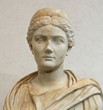Review
The work we have of her is directly related to her mission as Hadrian's chronicler during his trip to the Valley of the Kings. The news we have of her is provided by Julia herself in her work, in which she also gives us the exact date of that visit.
She was a court poet and lady-in-waiting to empress Vibia Sabina. Thus, she used her poetic resources, which were not few, to write poetry for the court, and did not hesitate to flatter the emperor's figure or that of his wife.
She wrote in Lesbian dialect, but used the elegiac distich in her verses.
Justifications
- Poet of whom four compositions in elegiac distiches remain engraved on the statue of Memnon.
- She wrote in Lesbian dialect, but adapted the metrical form of the elegiac distich.
- She was a lady-in-waiting to the empress Vibia Sabina and was part of her intellectual circle.
- Chronicler of Hadrian on his visit to the Valley of the Kings, in Egypt.
Biography
She was a character of illustrious lineage, daughter of a high Roman official and a Greek woman born in Alexandria and related to the royalty of Asia Minor. Her older brother was Gaius Julius Antiochus Epiphanes Philopappos, one of the first men of Eastern descent to become consul in Rome.
She was born and raised in Rome in 72 AD, in the house of his paternal grandfather, Antiochus IV. Balbilla's maternal grandfather, after whom she was named, was Tiberius Claudius Balbillus, a Greek man of Egyptian descent, astrologer and scholar, and Prefect of Egypt from 55 to 59 AD.
She received a great education and was a great intellectual, a good connoisseur of ancient poetry. She wrote in Greek -in Lesbian dialect-, following the Hellenizing style of the time. She even used Lesbian (in a somewhat artificial variant) to relate her poetic activity to the one who is always the model for all poets, Sappho.
She wrote four poems in elegiac distiches, inscribed on the statue of Memnon, during the visit of Emperor Hadrian and his wife, Vibia Sabina, who was her lady in the court, to the Valley of the Kings, in Egypt; in fact, she was the chronicler for that trip.
Bibliography
-Agudo, Francisco (2019).” Palabra articulada: 'Julia Balbila, Damo, Cecilia Trebula y Dionisia: poemas en la pierna de la estatua cantante’”, in Fundación Centro de Poesía José Hierro (ed), Nayagua, Revista de Poesía, 30, pp.131-134, (retrieved on 23/06/2021). <https://docplayer.es/159138214-Revista-de-poesia-una-temporada-en-la-nube.html>
-Bernabé Pajares, Alberto y Rodríguez Somolinos, Helena (1994). Poetisas griegas. Madrid: Ediciones Clásicas.
-Cortés Copete, Juan Manuel (2017).“El Coloso de Amenoph. Adriano, Balbila y Pausanias en Egipto” in Dionisio Pérez Sánchez et alii (eds). Poder y heterodoxia en el mundo greco-romano. Salamanca: Ediciones Universidad, pp. 189-208.
-García Tejeiro, Manuel (1984). “Notas sobre el vocabulario de los epigramas de Julia Balbila”, in Estudios clásicos, 26, no 87, (retrieved on 23/06/2021).
<http://interclassica.um.es/investigacion/hemeroteca/e/estudios_clasicos/numero_87_1984/notas_sobre_el_vocabulario_de_los_epigramas_de_julia_balbila>
-Luque, Aurora (2020). Grecorromanas. Lírica superviviente de la Antigüedad clásica. Barcelona: Ed. Planeta.
-Obrador Cursach, Bartomeu (2018). “El acento sáfico de Julia Balbila”, in Notae Tironianae, (retrieved on 23/06/2021).
<https://tironiana.wordpress.com/2018/06/20/el-acento-safico-de-julia-balbila/>
Didactic approach
-Classical culture: Block Classical roots of today's world. Everyday life; Block Continuity of cultural heritage. Literature, art and science.
-Latin 4th ESO: Block Legacy and heritage; Block The present of Latin civilisation.
-Latin Baccalaureate: Block Literary education.
-Universal Literature 1st Baccalaureate: Interpretation of fragments from the Roman period of different genres and themes.
-Spanish Language and Literature ESO: Literary Education Block.
Documents
